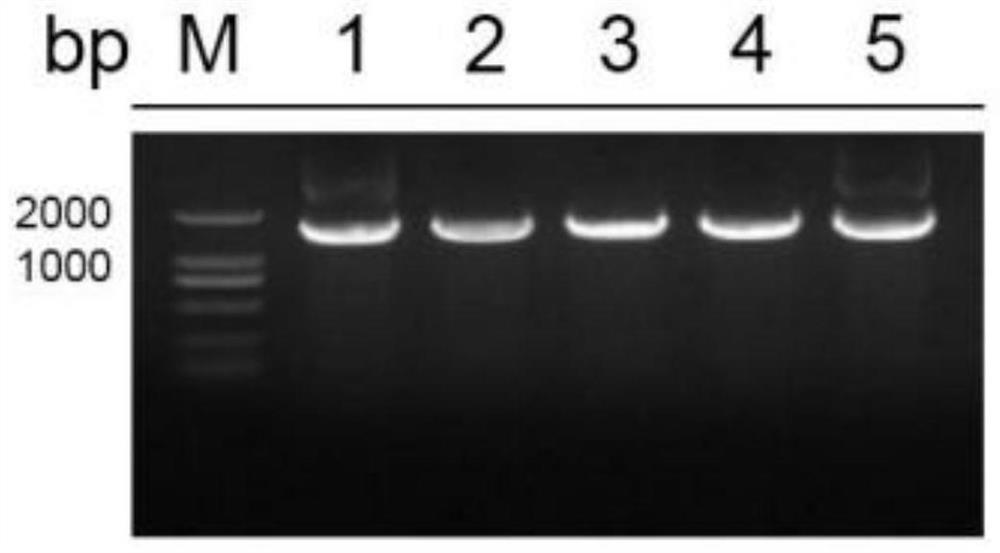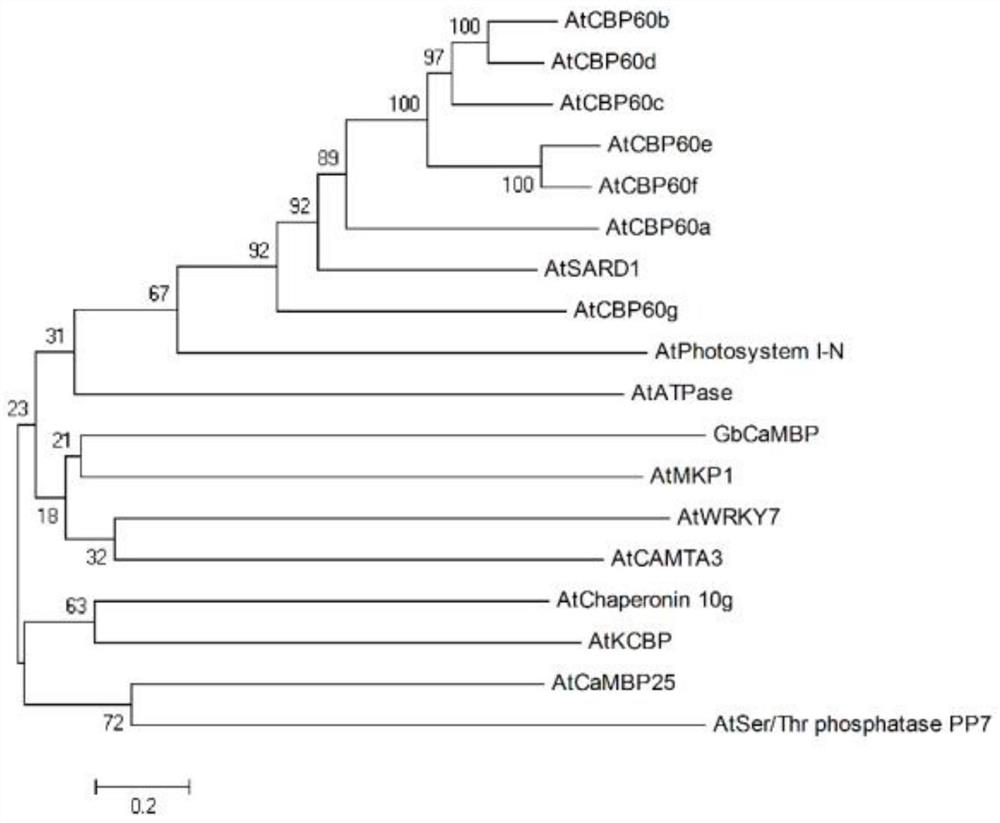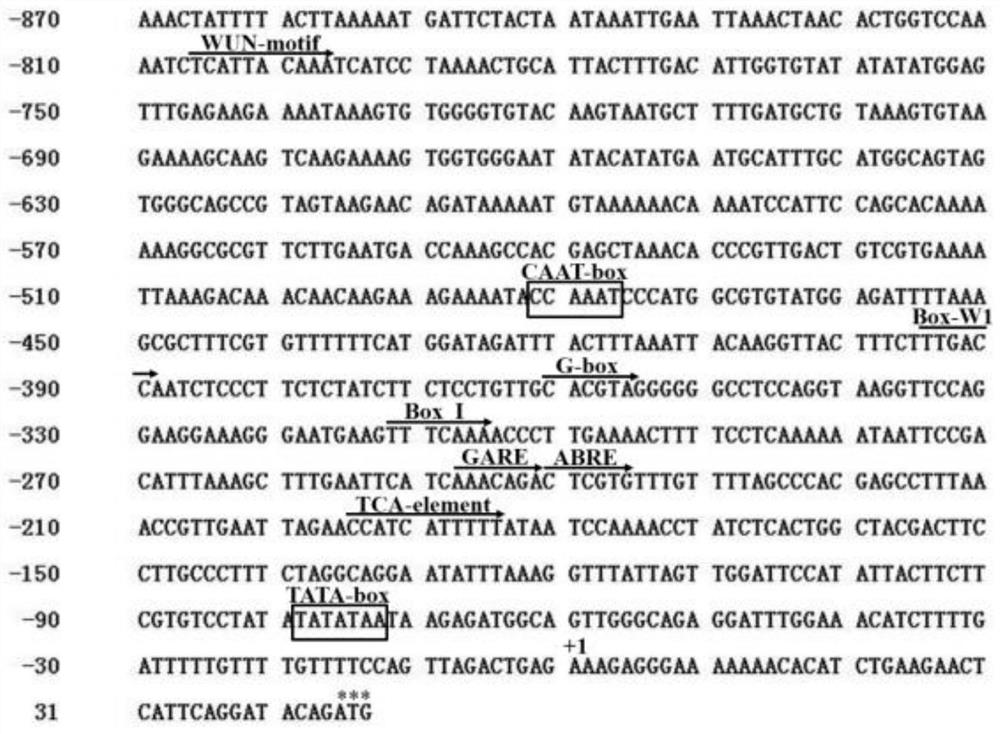Application of cotton gbcambp gene in plant resistance to Verticillium wilt
A technology of resistance to verticillium wilt and transgenic plants is applied in the application field of cotton GbCaMBP gene in plant resistance to verticillium wilt, and can solve the problems such as affected expression and the like
- Summary
- Abstract
- Description
- Claims
- Application Information
AI Technical Summary
Problems solved by technology
Method used
Image
Examples
experiment example 1
[0028] Experimental example 1: Cloning and bioinformatics identification of cotton calmodulin-binding protein gene GbCaMBP
[0029] 1. Cloning of GbCaMBP gene of sea island cotton
[0030] ① According to the extraction steps in the instructions of Aidlab's EASYspin Plus Plant RNA Rapid Extraction Kit, extract the total RNA of the sea island cotton Xinhai 15 species and reverse transcribe it into cDNA, and dilute the cDNA concentration to 50-60ng / μL. The seeds of sea-island cotton Xinhai 15 were provided by the Cotton Research Institute of the Chinese Academy of Agricultural Sciences.
[0031] ②The EST sequence of a calmodulin-binding protein gene was screened out through transcriptome sequencing analysis, and sequenced in the sea island cotton database of Huazhong Agricultural University (http: / / cotton.cropdb.org / cotton / tools / blast.php) Alignment, a complete cDNA sequence was compared, and a pair of amplification primers (F: ATGGGATTGTCTCTTTTCATTGC; R: TTAGCCCACTGTTGCTATAG) w...
experiment example 2
[0039] Experimental example 2: GbCaMBP promoter sequence cloning and bioinformatics analysis
[0040] Use (https: / / phytozome.jgi.doe.gov / pz / portal.html#!search?show=BLAST) software to find out the promoter sequence of GbCaMBP online, and amplify GbCaMBP from the genomic DNA of Gymnosporum xinhai 15 A 914bp sequence upstream of the start codon (ATG) was obtained. Using the promoter transcription start site prediction software TSSP to analyze this sequence, it is predicted that the transcription start site of GbCaMBP is the 44th base upstream of ATG (+1, A).
[0041] Use (http: / / bioinformatics.psb.ugent.be / webtools / plantcare / html / ) software to predict and analyze the cis-acting elements on the promoter sequence online, and the predicted results are as follows image 3 As shown, in addition to the core promoter sequence (TATA-box and CAAT-box), the promoter sequence of GbCaMBP also contains light-sensitive elements (Box I, G-box), fungal induction response elements (Box-W1) and ...
experiment example 3
[0042] Experimental Example 3: Correlation between GbCaMBP gene and cotton resistance to Verticillium wilt
[0043] 1. Analysis of the expression pattern of GbCaMBP gene in cotton
[0044] Cotton of sea-island cotton Xinhai 15 was planted, and when the cotton seedlings grew for about 3 weeks, the cotyledon, true leaf, stem, stem tip and root of cotton were taken as samples to analyze the tissue expression pattern of GbCaMBP gene. First, extract RNA from the sample that has been taken, then reverse transcribe it into a cDNA template, and dilute it to 10-20ng / μL, and use qRT-PCR technology to express the GbCaMBP gene in tissue using the ABI7500 Real Time PCR system (Applied Biosystems, USA) For pattern analysis, Ubiquitin 7 (UBQ7) was used as an internal reference gene.
[0045] The upstream and downstream primers of the GbCaMBP gene were designed as follows:
[0046] F: GATTGGTTGCTCGTGATGG
[0047] R: GCTTGCCCGTATGAGTTGT;
[0048] The primers for the upstream and downstream...
PUM
 Login to View More
Login to View More Abstract
Description
Claims
Application Information
 Login to View More
Login to View More - R&D
- Intellectual Property
- Life Sciences
- Materials
- Tech Scout
- Unparalleled Data Quality
- Higher Quality Content
- 60% Fewer Hallucinations
Browse by: Latest US Patents, China's latest patents, Technical Efficacy Thesaurus, Application Domain, Technology Topic, Popular Technical Reports.
© 2025 PatSnap. All rights reserved.Legal|Privacy policy|Modern Slavery Act Transparency Statement|Sitemap|About US| Contact US: help@patsnap.com



